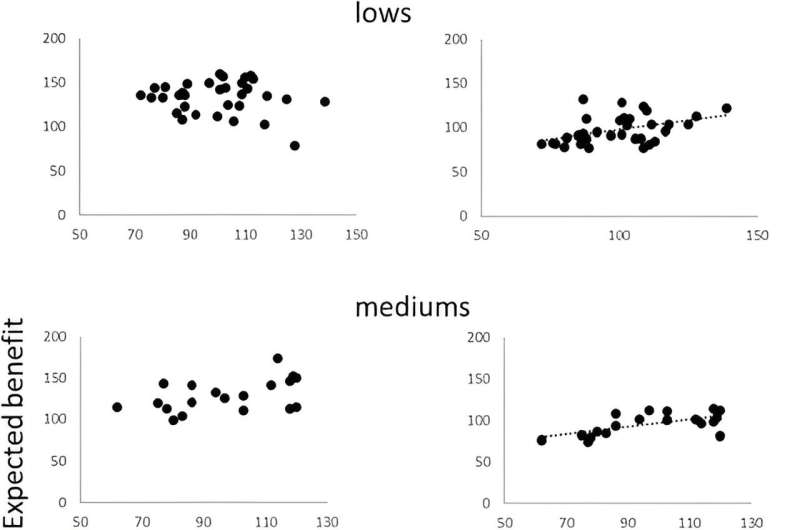January 31, 2024 feature
This article has been reviewed according to Science X's editorial process and policies. Editors have highlighted the following attributes while ensuring the content's credibility:
fact-checked
peer-reviewed publication
trusted source
proofread
Is hypnotizability related to risk-taking behavior?

In their daily lives, humans can encounter many situations that can put them at a varying degree of risk, or in other words, situations in which their choices can increase or decrease the possibility that an adverse event will occur. In these situations, different people can be more or less prone to engage in risk-taking behavior, such as gambling or investing large sums of money.
Some past studies suggest that a person's risk-taking tendencies could be related to the degree to which they are susceptible to hypnosis, also known as hypnotizability. However, the relationship between these two human characteristics remains poorly understood.
Researchers at University of Pisa in Italy recently carried out a study exploring this relationship, using a psychological task probing risk-taking behavior and a test of hypnotic susceptibility. Their findings, published in Neuroscience Letters, highlight different associations between the perception of risks and propensity to risk-taking among people scoring low, medium or high in the hypnotilizability test.
Hypnotizability, broadly defined as a proneness to adapt perceptions, memories and behaviors following hypnosis and hypnotic suggestions performed even while conscious, is considered to be a stable trait. This means that this characteristic does not generally tend to change much over time.
"Some hypnotizability-related neurophysiological and behavioral correlates suggest that hypnotizability level, measured by standard scales classifying individuals as low (lows), medium (mediums) and high hypnotizable (highs) subjects, can be related to risk propensity and risk-taking," Francy Cruz-Sanabria, Ugo Faraguna and their colleagues wrote in their paper.
"To study whether hypnotizability modulates risk propensity and behavior, we recruited healthy participants, classified through the Standford Hypnotic Susceptibility scale (form a) and compared lows' (n = 33), mediums' (n = 19) and highs' (n = 15) experiential and behavioral risk perception and propensity variables through the Domain-specific risk-taking scale and the Balloon Analog Risk Task," the team continued.
Cruz-Sanabria, Faraguna and their colleagues carried out a series of experiments involving 67 participants who had previously completed an hypnotic susceptibility assessment, using the Italian version of a well-established test to measure hypnotizability. These participants were asked to complete two different tasks.
Firstly, they completed a questionnaire asking them to rate specific behaviors in terms of how risky they perceived them to be, how much these behaviors could have benefited them, and how likely they were to engage in them. Subsequently, they took part in 90 trials of the balloon analog risk task, a behavioral task designed to assess the propensity of individuals to engage in risk-taking behavior.

During the balloon analog risk task, people are presented with three types of balloons, characterized by their different coloring. By pressing a key on a keyboard, the subject can cause the presented balloons to inflate, allowing them to gain 1 euro.
Money accumulates every time they inflate the balloon, but when a balloon explodes, all accumulated funds are lost. The participants can decide to move the money they accumulated to a "virtual bank" at any point in time to secure it, or continue inflating the balloons to increase the profit.
Notably, balloons of different colors have a different probability of exploding, but this information is not shared with participants at the beginning of the task. The researchers analyzed the behavior of their study participants during this task (i.e., how many times they pressed the key to inflate balloons and how often they transferred money to the bank), in conjunction with their answers in the questionnaire and their rating in the hypnosis susceptibility test.
"Results indicated that different hypnotizability levels are not associated with different risky behavior and experience, except for higher expected financial benefits from risky behavior in lows," Cruz-Sanabria, Faraguna and their colleagues wrote. "However, hypnotizability-related risk profiles were identified through correlational analyses. In fact, highs exhibited a negative association between risk perception and propensity to risk-taking, whereas mediums and lows displayed a positive association between risk propensity and expected benefit."
Overall, Cruz-Sanabria, Faraguna and their collaborators found that the hypnotizability of individuals does not necessarily predict their perception of risk and their risk-taking behavior in tasks that entail making risk-related decisions. Nonetheless, the researchers were able to delineate different risk-related profiles, which appear to be associated with distinct patterns in risk perception and risky behavior.
Specifically, they found that participants who scored high on the hypnotizability scale tended to engage in more automatic behavior compared to those who scored medium or low. In contrast, those scoring medium or low in the hypnotizability scale appeared to focus more on the potential benefits of risky actions, thus suggesting that when they engaged in risky behavior they did so not automatically, but rather as a conscious choice.
The team's sample of participants was not particularly large, but further studies could help to validate these findings. In the future, this work could also pave the way for additional research focusing on the link between hypnotizability and automatic behaviors, potentially leading to interesting new discoveries.
More information: Francy Cruz-Sanabria et al, Hypnotizability-related risky experience and behavior, Neuroscience Letters (2024). DOI: 10.1016/j.neulet.2024.137625.
© 2024 Science X Network




















